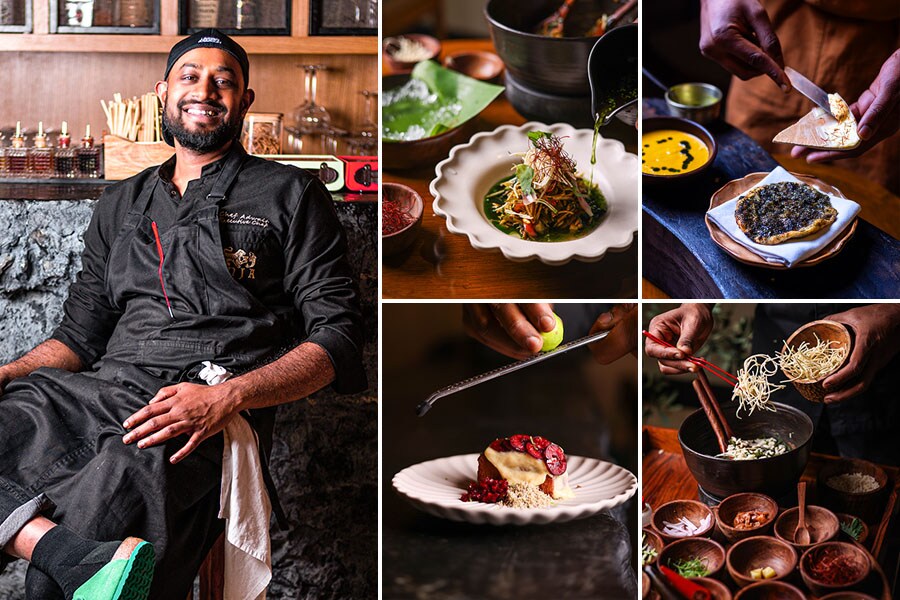Ramen in Ludhiana, sushi in Kothrud
How Indian-Japanese became India's most popular restaurant food — and is stirring up middle India's interest in all things Japan
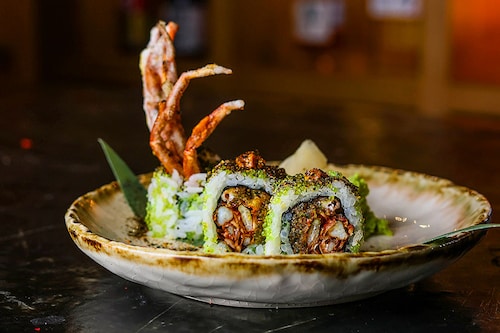

This March, as the Sakura season arrives, chef Vanshika Bhatia, one of India’s top young chefs, will be headed to Japan—on her honeymoon. “We have it all planned, the ramen and the sushi, the noodle and the whisky bars", she chuckles. Bhatia is, of course, a professional and the trip is clearly mixing work with pleasure. But she also represents a cross-section of middle-class Indians gravitating towards Japan, mediated by their love for Japanese food, often Indianised.
Purists like Bhatia and connossieurs aside, a majority of Indian consumers are buying into an idea of Japanese food that is distinctly Indian—with flavours amped up even when ingredients and techniques are Japanese, cooked by young Indian chefs who use regional Indian produce, vegetarian substitutes, and, in general, a cult of sushi, ramen, teppanyaki that is more cooked, more seasoned and more sauced than anything you may find in Japan. Or, even in California, despite its mayo-laden maki rolls.
The popularity of this contemporary Indian-Japanese cuisine is exploding, overturning Japanese food’s elitist image as a luxury cuisine in the past two decades.
Post pandemic, driven by increased social media consumption and an aspiration to internationalism, middle-class Indians are discovering Japanese food—and Japan—in more democratised formats, even in smaller metros and tier 2 cities. While it was conventionally believed that Indian and Indian-Chinese were the highest-selling restaurant cuisines in India, Indian-Japanese may in fact be overtaking Indian-Chinese in popularity.
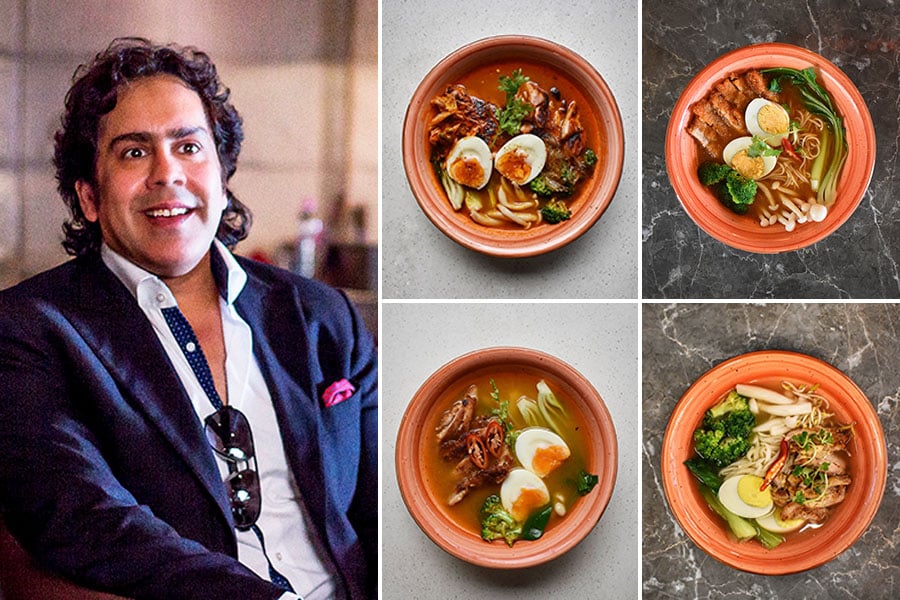 Kylin has been expanding rapidly in Punjab and Uttarakhand, and restaurateur Saurabh Khanijo says their sushi and ramen are most popular items in Chandigarh and Dehradun.
Kylin has been expanding rapidly in Punjab and Uttarakhand, and restaurateur Saurabh Khanijo says their sushi and ramen are most popular items in Chandigarh and Dehradun.
According to Kikkoman, the popular Japanese soy sauce brand, Japanese food has seen a huge spurt in India in the last two-three years. Check out #ramen on Insta, and you will chance upon social media cooks giving you tips on how to cook the perfect veg broth or ramen in 10 minutes and so on, even though cooking a legit tonkotsu (pork bones) broth from scratch is a time-consuming process, taking at least 6 to 8 hours of simmering to achieve a coveted depth of flavour.
But in India, adapting to local tastes, dietary restrictions and convenience, ramen may be the new Maggi—ironical because the 2-minute noodles were a take on instant ramen. “In Dehradun, our ramen festival was a super hit," says restaurateur Saurabh Khanijo of Kylin, a chain of pan-Asian restaurants with a focus on Japanese that has been rapidly growing in Punjab and Uttarakhand. The soupy bowls included a “health forest" ramen with veggies simmered in miso-sriracha, chilli salmon ramen, and even a prawn coconut soup.
 According to Khanijo, though Indian Chinese was the most popular cuisine earlier, the fascination with Indian-Japanese is now evident. Demand is shooting up because it is perceived as healthier and novel. “Forty percent of my menu at Kylin is Japanese, and sushi is the most popular item," he says, “though ramen is getting very popular at our outlets in Chandigarh and Dehradun." Then, there is teppanyaki, the new healthy “tak-a-tak" popular in Punjab, and California-style maki rolls laden with chilli mayo, filled with tempura-battered prawns and such, pop foods in India now.
According to Khanijo, though Indian Chinese was the most popular cuisine earlier, the fascination with Indian-Japanese is now evident. Demand is shooting up because it is perceived as healthier and novel. “Forty percent of my menu at Kylin is Japanese, and sushi is the most popular item," he says, “though ramen is getting very popular at our outlets in Chandigarh and Dehradun." Then, there is teppanyaki, the new healthy “tak-a-tak" popular in Punjab, and California-style maki rolls laden with chilli mayo, filled with tempura-battered prawns and such, pop foods in India now.
Tempura flour, shichimi (spice powder), togarashi (peppers, used to make the shichimi spicier) and different types of miso are all Japanese condiments being used liberally to create a genre of boldly flavoured Japanese-ish food tailored for the Indian palate.
“What people are eating today is highly seasoned dishes with togarashi and chipotle mayo and Kikkoman is almost like table salt in restaurant kitchens. I would like to see something subtle like cha-soba [delicate tea flavoured cold soba noodles] gain currency", says chef Saby Gorai, who once headed AD Singh’s Ai, the first luxury standalone Japanese restaurant in the country that opened in 2008 but failed to take off.
Singh then started Guppy by Ai, a more casual, smaller restaurant, which continues to do well serving more "authentic" Japanese food. But an attempt to scale up a lighter version of this just before the pandemic failed. Singh had to shut Hello! Guppy in Mumbai because, as he tells me, its elegant aesthetic, food that was not over-flavoured and an international vibe (targeted, say, at couples instead of large families) did not click with the audience then.
This was in 2020. Now, both Japanese food, and restaurant formats are redefining earlier tropes. “In the beginning, I was resistant to keeping something like teriyaki chicken sushi in Chandigarh. There is nothing like that in Japanese food. But then, I found others selling it and customers wanting it, so I had to give in. Now, it is a best-seller," says Khanijo.
Customising to the local palate is, of course, important for businesses. “In Hyderabad, the Japanese menu is doing very well, everyone is well travelled or studied in the US, so there is a great demand even for the cold plates and people are ready to pay high prices for food done with finesse," says Ashish Kapur of the upscale Whisky Samba, which has just opened an outlet in Hyderabad, “but the South Indian palate is used to high spice, so it is important to amp up flavours."
Even the big fat Indian weddings, the most visible symbols of Indian maximalism now regularly have torched and mayo-ed sushi, ramen, ceviche, yuzu and chilli-laced cold plates, and teppanyanki.
Well-to-do, middle-class Indians exposed to this Japanese food deemed healthy and chic (as well as to American-Japanese on their travels) are in fact drawn to Japan as a destination and culture from this exposure.
Chef Adwait Anantwar is creating a unique fusion at Inja where Indian street food such as the Bombay sandwich and Bhel are made with luxe Japanese ingredients.
If Indian-Japanese is emerging as a legit cuisine and the first exposure to Japan for many Indians, it is hardly the only legit example of fusion. Given how influential Japan and its cultural products are globally, there is scarcely a top global chef today not influenced by the techniques and nuances of Japanese food culture—even while doing his or her own distinctive food.
Californian-Japanese emerged in the US as a result of long-standing immigration in different waves, from the beginning of the late 19th century. Little Tokyos emerged all over the West Coast. Despite the drop around World War 2 till the 1960s, when US states started permitting Asian immigrants to become citizens, the strong Japanese-American community in the US, and Japan’s huge cultural influence in the West via its cinema, design, fashion and gaming, birthed an American-Japanese fusion food that has further spread Japanese-inspired gastronomy in the dining capitals of the world.
There’s also Nikkei food, currently uber trendy. Peruvian-Japanese, with its own history —where South American ingredients such as chilli, lime, and yuca give a bolder twist to Japanese. In India, Nikkei restaurants have been coming up in the last one year, and we now have at least three, with ceviche and its cousins trending.
But there is a catering to the local palate even here. At Heliconia, at the JW Marriott Goa, expat Peruvian chef Arturo Castro Salazar not only serves up the likes of tuna tataki but also a substantial vegetarian menu—almost 50 percent of the dishes are vegetarian with the chef using imported Peruvian potatoes, corn and other ingredients . “People are ready to pay any price, but there is a lot of demand for vegetarian options that are exotic and spicy," he says.
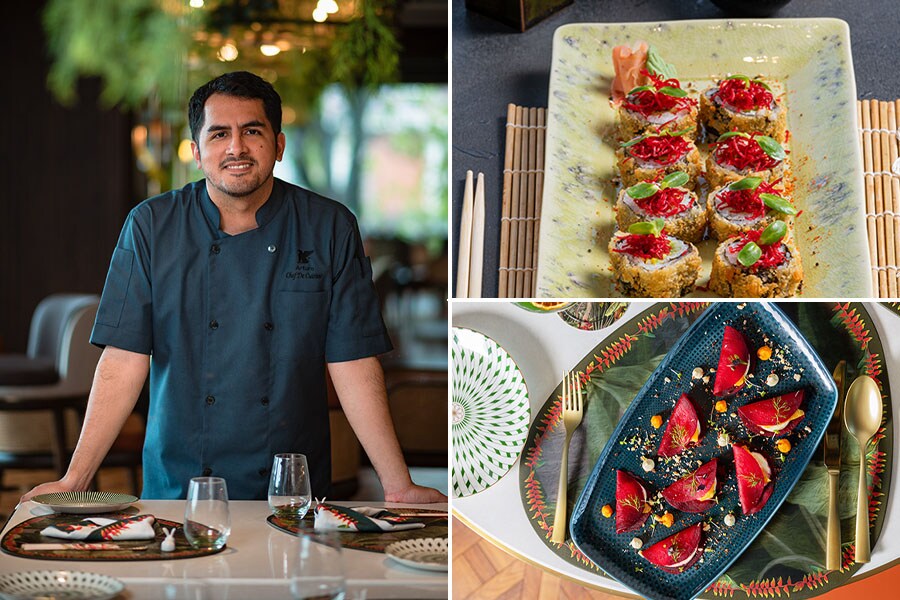 Peruvian Japanese arrives in Goa at Heliconia but expat chef Arturo has created a huge line up of veg dishes to cater to HNI Indians.
Peruvian Japanese arrives in Goa at Heliconia but expat chef Arturo has created a huge line up of veg dishes to cater to HNI Indians.
Then there’s the global fascination with Italian-Japanese, not a surprising fusion given how carpaccio—pounded, thin slices of raw meat or salmon supposed to have been invented by Giuseppe Cipriani at the famous Harry’s bar in Venice in the 1960s—is well accepted at most contemporary Japanese restaurants that also use truffles and the like.
It is this inventive, international Japanese that caught on in India as a luxe cuisine at the turn of the millennium—after Wasabi opened at the Taj Mahal Mumbai in 2004, helmed by Morimoto, protegee of the Peruvian-Japanese chef Nobu. Black cod miso, a Nobu classic, became India’s most expensive and aspired-to dish, and “ladies who lunched" then took sushi rolling lessons at Wasabi.
Post pandemic, as a newer demographic aspires to internationalism in cash-rich smaller towns and smaller metros, inventive Japanese is getting democratised and localised. “Our sushi rolling classes were a big hit in Dehradun," says Khanijo. In Pune, at top Japanese restaurant Ukiyo at the Ritz Carlton, many dishes marry star ingredients such as parmesan and truffles with Japanese techniques. “We get diners from Mumbai also, and contemporary Japanese does well since Indians don’t like raw food," says general manager Nishant Vishwanath. An event in Kothrud, the hub of Pune’s conservative Kokanastha Brahmin community, recently saw an exhibition on the history of sushi that drew a big crowd undeterred by the warning “there is no food being served here"!
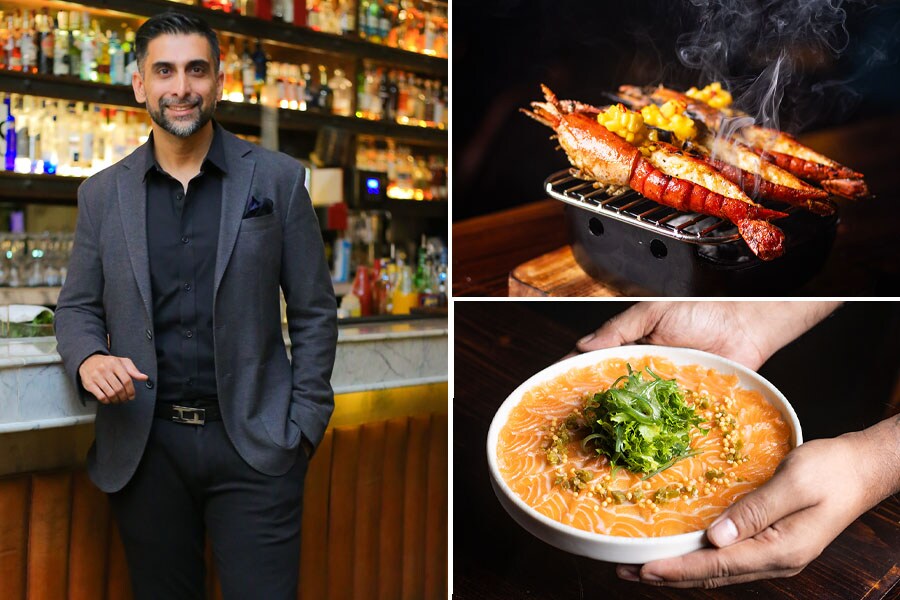 Even cold plates are doing well at the new Whisky Samba Hyderabad but restaurateur Ashish Kapur says flavours need to be amped up.
Even cold plates are doing well at the new Whisky Samba Hyderabad but restaurateur Ashish Kapur says flavours need to be amped up.
Middle-class India’s new love for Indian-Japanese is spurring interest in Japan as a destination. Ask around and chances are that one of your acquaintances is planning a trip to the country, Or has just been there!
Since Japan opened its doors to tourism in late 2022, the country has been luring higher paying international travellers. It emerged as the top trending destination globally for 2024, according to Tripadvisor. Its annual tourism numbers are on an upswing, and have surpassed 2019 levels, with India emerging as one of the top emerging markets, as per Japan National Tourism Organisation (JNTO).
A JNTO report said that Indians in 2023 spent more than $1,500 per person—crossing the minimum spend that Japan has been aiming to earn from its tourists as per its new policy to focus only on higher-paying tourists. Discerning Indian travellers are spending on cultural experiences, including food, as per JNTO.
Meanwhile, at the weddings, Japanese aesthetics have spilled into other domains than food. Wedding planners speak about quaint Geisha fans as accessories and “Japani" henna designs that mehndi artistes from Gujarat’s Surat to Delhi’s Lajpat Nagar are peddling.
“These are new mehndi patterns with minimalistic designs like cherry blossoms, or even anime-like details of the dog or car or dates associated with the groom or the bride that are in," says Shriya Garg, a graduate in retail and fashion merchandising. Mukta Kapoor, director, Yuna Weddings, elaborates: “Japanese themed nights have been gaining in popularity, especially since many young couples are fond of Japanese food and inspired by the country. Zen garden or cherry blossom decors are popular, especially at destination weddings."
In his 2006 book Japanamerica: How Japanese pop culture has invaded the US, Japanese-American writer Roland Kelts traces the takeover of American pop culture by Japanese cultural products in the 1980s. Japanese manga, anime and Kawaii or the culture of cuteness have had an impact on Western subcultures, something that Kelts traces to the Nintendo takeover of America’s video gaming industry in the 1980s.
Did India have such a moment? A case can be made tracing the current millennial and Gen Z fascination for Japan to the serialisation of dubbed manga series that began in 2005-2006. An entire generation in India that grew up watching Shin Chan, Ninja Hathori et al on TV in Hindi, Tamil and Telugu, and food programmes such as Iron Chef Japan, seems to be driving demand and supply.
Young chefs like Shubham Thakur of Megu, influenced in their teens by Japanese programming on TV, are creating their own genre of food marrying precise Japanese techniques with local ingredients.
Chef Shubham Thakur, one of India"s top Japanese chefs, who heads the fine dining restaurant Megu and Japanese food at The Leela hotels, remembers being enamoured by Iron Chef Japan as a school kid. "Since both my parents were working, the 2 pm show was big for me. After returning from school, I would watch [chef] Morimoto San, and was fascinated. It was from watching him that I began to understand their way of speaking, their culture," he says.
This influenced his career choice. "Back in 2013, there was a craze for Italian, and if you wanted to make it big as a chef, you had to know how to cook perfect pasta. But I chose Japanese and worked with a Japanese master chef at the Leela, perfecting techniques, even something like how to filet fish, how to use their knives that Indians don’t have no muscle memory of," he says.
Chefs like Thakur who are technically sound and understand Japanese nuances are also creating a genre of refined Indianish-Japanese food, more subtle than massy offerings, but using nevertheless some local Indian produce.
“We must respect our local ingredients", Thakur tells me, while pointing out how many Japanese veggies and even rice varieties are now being cultivated in India—from Japanese pumpkin to lettuce and shiso leaf. “Using local ingredients with Japanese techniques to bring out their flavour, or experimenting while keeping the essence of the culture and cuisine is important," he says.
In the leafy neighbourhood of the capital’s Friend’s Colony, at The Manor, where Indian Accent once debuted, a new curious experiment is afoot—a logical culmination of this dalliance between two opposite sensibilities.
There’s nori-dusted kulcha topped with togarashi-butter, Bombay sandwich with fatty fresh Hamachi, sprinkled with bonito flakes instead of aloo lachcha. And then there’s the bhel-- Murmura and fried noodles, wakame and shitake, nori chutney (!), brought together by a kombu dashi. The year-old restaurant Inja (short for Indian-Japanese) has been opened by the Dubai-based hospitality major Atelier House hospitality and is an unabashed fusion experiment by chef Adwait Anantwar, who also helms a chain of Indian street food restaurants in Dubai but got fascinated by Japanese cooking. His flavours are fresh and understated, and there is finesse to this fusion.
As a new Indian-Japanese subculture cooks up, the fusion seems like the genesis of something new.
First Published: Feb 20, 2024, 12:35
Subscribe Now